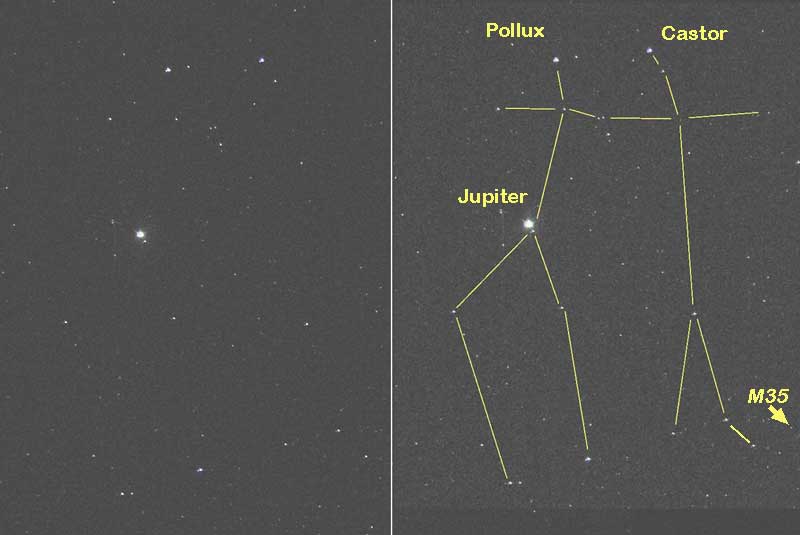Excerpts from Jim Conrad's
Naturalist Newsletter

from the October 13, 2013 Newsletter issued from the Frio Canyon Nature Education Center in the valley of the Dry Frio River in northern Uvalde County, southwestern Texas, on the southern border of the Edwards Plateau; elevation ~1750m (~5750 ft); N29.62°, W99.86°; USA
JUPITER IN GEMINI
Each morning a little before dawn when I step outside to begin my jog, if a clear day is in store, I'm greeted by a dazzlingly starry sky. Right overhead it's easy to make out the constellation Orion with its five bright stars defining the hunter's head, shoulders and feet, and smaller stars making his belt and sword. We've looked at Orion at https://www.backyardnature.net/n/x/orion.htm.
As I run southward, part of the sky just to the left, or east, of Orion's shoulder is dominated by the sky's brightest-of-all-stars, the Dog Star, Sirius. Sirius displays a "visual apparent magnitude" of -1.46 -- the lower the number, the brighter the star. Sirius is almost twice as bright as the sky's second brightest star, Canopus.
However, on these October mornings, something in the sky not too far from Sirius, and which isn't the Moon, is even brighter than Sirius. It shines with a dazzling apparent magnitude of -2.3. It's the planet Jupiter.
Nowadays Jupiter lies within the constellation Gemini, known as "The Twins" in English. At the top of this page you see a time exposure, with the left side of the picture showing Jupiter glowing brightly more or less in the center, and the left side displaying the same part of the sky but with Gemini's structure drawn in, and with some labels added.
In that photograph -- with north at the top -- Pollux forms the head of the twin on the left, while Castor designates the head of the other twin. Pollux is a giant star with a visual magnitude of 1.1, and is about 33.78 light-years from Earth. Castor is actually more than one star. It's a sextuple star system (six stars) 52 light-years from Earth, with a magnitude of 1.6. You can see that Jupiter right now inhabits the place where the legs of the twin on the left come together.
M35 is a star cluster that's hardly visible in the picture, and I can't make it out with my naked eyes as I run. It should show up with binoculars, however. It consists of about 200 stars arranged in chains curving throughout the cluster, and it's about 2800 light-years from Earth. Since our galaxy, known as the Milky Way, is 100,000–120,000 light-years in diameter, M35 is a relatively near part of our own galaxy. You can see M35 and read about it at http://messier.seds.org/m/m035.html.
Wikipedia's Gemini page has much more information about the constellation Gemini and objects found in it at https://en.wikipedia.org/wiki/Gemini_(constellation).
As the months pass, it'll be interesting to watch Jupiter slowly wander across the sky. My star-chart program shows that this time next month it'll still be in Gemini, but a bit to the left, or east, of where it is now. Its normal direction is toward the east, relative to the star patterns behind it. However, on November 7th of next month, Jupiter will appear to stand still, then begin moving backwards, or in "retrograde motion," toward the west. It'll continue in retrograde westward motion until March 6, 2014, when it'll appear to turn around once again, and return to heading east. Of course Jupiter isn't really turning around -- it just appears so from Earth as both Earth and Jupiter orbit the sun at different speeds. A webpage doing a nice job explaining all this is at http://earthsky.org/tonight/jupiter-appears-to-stop-then-change-direction.
It takes 11.86 Earth years (or 4332 days) for Jupiter to orbit the Sun.